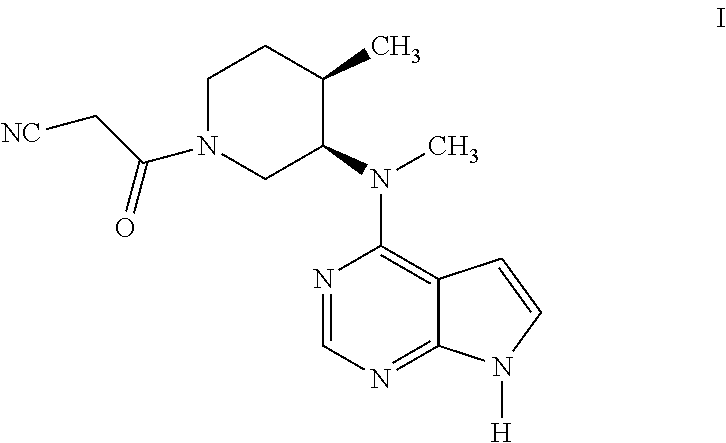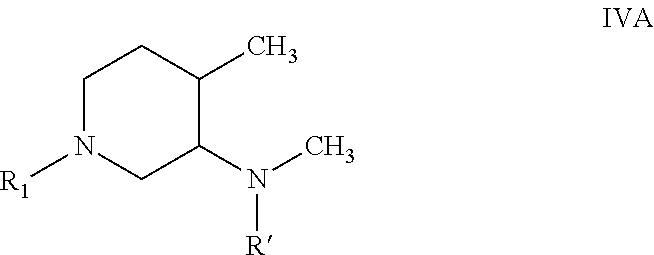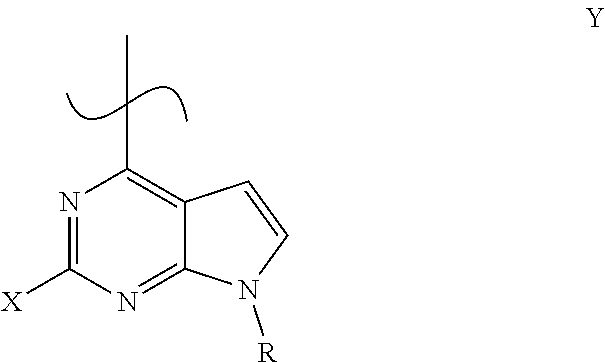Process for the preparation of tofacitinib and intermediates thereof
a technology of tofacitinib and process, which is applied in the field of new process preparation of tofacitinib, can solve the problems of reducing product yield, time-consuming and laborious prior art processes, and reducing product yield
- Summary
- Abstract
- Description
- Claims
- Application Information
AI Technical Summary
Benefits of technology
Problems solved by technology
Method used
Image
Examples
example 1
on of methyl-(4-methylpyridin-3-yl)carbamate
[0463]To a suspension of 4-methylpyridine-3-amine (25 gm, 0.23 mol) in 125 ml dimethyl carbonate was added potassium t-butoxide lot wise at about 10-15° C. and the reaction mass was stirred for about 1 hr at about 10-15° C. The progress of the reaction was monitored by TLC. After completion of the reaction 100 ml of water was added to the reaction mass at about 10-15° C. The temperature of the mass was raised to about 20-25° C. and 100 ml of ethyl acetate was added. The mass was stirred for about 30 min and layers were separated. The ethyl acetate layer was washed with 50 ml water and concentrated under vacuum at about 50-55° C. to afford a residue. The residue was taken in di-isopropylether and stirred for about 1 hr at about 25-30° C. The precipitated solid was filtered and dried under vacuum at about 40-45° C. to afford 35 g methyl (4-methylpyridin-3-yl)carbamate.
example 1a
n of methyl-(4-methylpyridin-3-yl)carbamate
[0464]250 ml 25% sodium methoxide solution in methanol was distilled under vacuum and stripped out with toluene. 100 ml of toluene was charged to above reaction mass followed by 50 gm (0.46 mol) of 3-amino-4-methyl pyridine and 250 ml dimethyl carbonate. The reaction mass was heated to about 60-65° C. and maintained at this temperature for about 1.5-2.0 hrs. After completion of reaction excess of dimethyl carbonate was distilled under vacuum and methylene dichloride and water was added. The methylene dichloride layer was separated. Aq. layer was extracted twice with methylene dichloride. The combined methylene dichloride layer was washed with water. Organic layer was distilled under vacuum to afford a thick solid residue. Ethyl acetate was added to the residue under stirring at 55-60° C. and n-heptane was added slowly. After completion of addition, reaction mass was further cooled to room temperature and stirred for 5-6 hrs at same temperat...
example 2
on of methyl-(4-methylpiperidin-3-yl)carbamate
[0465]To a solution of methyl (4-methylpyridin-3-yl)carbamate (33 gm, 0.19 mol) in 500 ml acetic acid was added 8.0 gm of 5% rhodium on alumina type 525 and the reaction mixture was hydrogenated in autoclave at about 70-75° C. under hydrogen pressure of about 7-8 kg / cm2 for about 10 hrs. The progress of the reaction was monitored by TLC. After completion of the reaction the reaction mass was filtered through hyflow bed to remove the catalyst and the filtrate was concentrated under vacuum at about 60-70° C. to afford 30 gm methyl (4-methylpiperidin-3-yl)carbamate as a thick oil.
PUM
| Property | Measurement | Unit |
|---|---|---|
| chiral purity | aaaaa | aaaaa |
| temperature | aaaaa | aaaaa |
| temperature | aaaaa | aaaaa |
Abstract
Description
Claims
Application Information
 Login to View More
Login to View More - R&D
- Intellectual Property
- Life Sciences
- Materials
- Tech Scout
- Unparalleled Data Quality
- Higher Quality Content
- 60% Fewer Hallucinations
Browse by: Latest US Patents, China's latest patents, Technical Efficacy Thesaurus, Application Domain, Technology Topic, Popular Technical Reports.
© 2025 PatSnap. All rights reserved.Legal|Privacy policy|Modern Slavery Act Transparency Statement|Sitemap|About US| Contact US: help@patsnap.com



